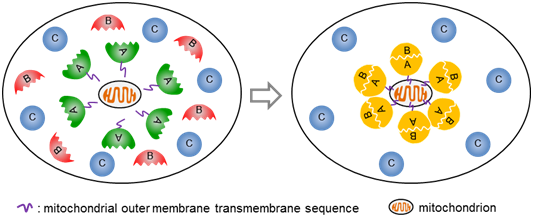Mito-docking can be used as a novel method to detect protein-protein interactions in vivo
Date:05-07-2019 | 【Print】 【close】
Many methods have been developed to detect protein–protein interactions (PPIs) and explore cellular processes. However, effective methods for detecting complicated PPIs under physical conditions are still in demand.
In a recent study, a simple and efficient mitochondria‐docking (Mito‐docking) method for PPI detection in vivo is developed by the research team led by Prof. HU Zhihong and Dr. WANG Manli. The strategy is to anchor a “bait” protein to mitochondrial outer membrane (MOM), and then trap the “prey” protein onto MOM. In this way, interacting signals are enriched to allow easy detection. This method efficiently detects the well‐known interaction between two G protein subunits (Gγ2 with Gβ1) and is successfully applied to investigate the recognition of importin α superfamily members for the classical nuclear localization signal (NLS) of simian virus 40 (SV40) large T antigen, which are highly dynamic and not easily visualized by conventional methods.
As far as is known, this is the first time that the interaction between human importin α receptors with NLSs has been visualized. The results prove that Mito‐docking can be used as a simple, straightforward, and intuitive method to study PPIs qualitatively and quantitatively in vivo.
The study was published in Small Methods entitled “Mito-docking: A novel in vivo method to detect protein-protein interactions”.
This work was supported by the Chinese Academy of Sciences, National Natural Science Foundation of China, and State Key Laboratory of Virology.

Contact:
WANG Manli
E-mail: wangml@wh.iov.cn
Wuhan Institute of Virology, Chinese Academy of Sciences, Wuhan 430071, China. (http://english.whiov.cas.cn/)